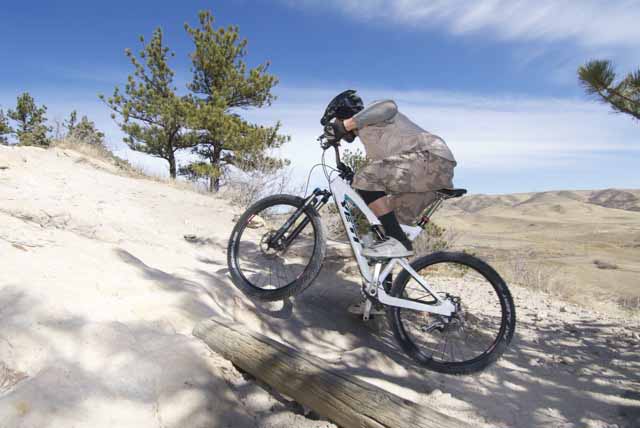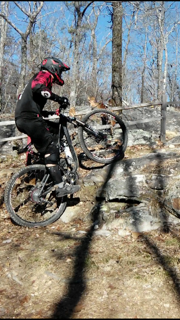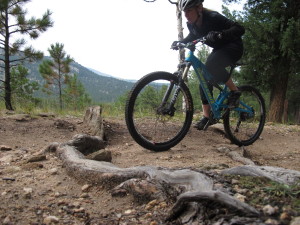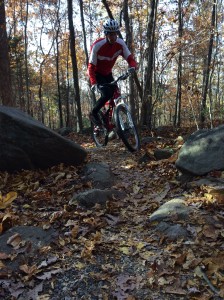MTB Technical Climbing
MTB Technical Climbing. In the following, I will address proper climbing body position and its importance while ascending steep and technical climbs and also debunk a couple of infamous myths regarding climbing on your MTB.
While we can get away with sloppy technique on relatively easy climbs and still make it to the top, when things get steep and loose (when traction is at a minimum) and obstacles such as water bars, erosion ruts, baby-head sized rocks, and who-knows-what-else, begin to appear on the trail (these things almost always naturally appear more often when the trail gets steep—dirt doesn’t like to stick to steep inclines, so it erodes, exposing the obstacles), our technique needs to be nearly perfect to top the climbs. Simply pedaling harder – as we all know – won’t get it done! Also, proper technique will save you huge amounts of energy even on climbs that you currently may actually make, but maybe waste a bunch of energy in the process because of not-so-great technique.
Losing traction, “bogging out”, doing accidental wheelies, and/or getting a case of the “swirvies”, are all common causes of riders not making it to the top of technical ascents. My guess is you’ve experienced all of the above issues when trying to ascend steep terrain (I think we all have!). While other aspects of riding technique such as proper use of vision (extremely important); proper gear selection, or cadence (very often overlooked – even by “good” riders); and others, are essential in order to make it to the top, proper body position will do a ton to help alleviate the above “climb killers”.

Forward on the seat, chest down, weight over the bottom bracket of the bike…That’s good climbing position…
First, let’s talk about weight-shifts. Take a look at the photo. Notice how far forward I have scooted on my saddle. Is that comfortable? Nope! However, very rarely will you need to move this far forward for an extended period of time (Most saddle companies do make saddles built with things such as the “enhanced climbing nose” to make being in this position as comfy as possible. If it is too painful to move this far forward with your current saddle, look into a different one. Your grundal will thank you!).
Why move this far forward? A couple reasons: if your bike is set-up correctly for you on flat ground and you feel like you’re in a good position to comfortably and effectively apply power to the pedals, what happens when your front wheel is elevated perhaps a foot, like in the photo? Your hips (your center of mass and origination of balance and power) have now moved rearward in their relationship with your feet (your effective applications of power). Moving forward – shifting your weight forward – helps you maintain your “power position” as much as possible when the front of the bike becomes elevated, enabling you to continue to effectively apply power to the ground when things get steep. Another very important reason that I move this far forward on the saddle: I put more weight on the front of the bike. Accidental wheelies and cases of the “swervies” (when your front wheel begins to wonder uncontrollably all over the trail, making it impossible to hold your line) occur because there is too much weight on the rear of the bike (not enough on the front). Shifting your weight forward will help to prevent these things from happening.
Even slight movements, or shifts, of the hips make a huge difference in our ability to ride the bike (contributing massively to weight placement, balance, power delivery). I am almost constantly making weight shifts – moving my hips fore and aft – on the saddle when ascending. A gentle climb with a small grade? I move forward only slightly – maybe a quarter of an inch. Medium grade? Medium movement – perhaps an inch … Steep as heck? All the way forward – as far as possible.
Eventually, on super steep stuff, you will have to come out of the saddle. If you stay seated, your mass will simply be too far back in relation to the bike and the front end will have no weight on it, thus no control and a case of the swervies. In the clinics, I constantly refer to having our weight over the bottom bracket of the bike and riding the bike through the BB. Not only is this going to be the most stable and calm area of the bicycle (the bike will pivot around the BB by design), but, if we have our weight—or, our line of force, as I often refer to it—going through the BB, both wheels will be properly weighted: the front will be planted allowing for control and steering and the rear will be weighted properly for traction. This is the way the bike is designed to work. This is huge. Will it take a little more energy to get out of the saddle? Yep. But, you have no choice on the super steep sections of climbs.
Another massively overlooked part of proper body position on steep climbs is the position of your upper body. Get that chest down!!! Look at the photo above. My chest is literally only a few inches off of the stem, and, when the front wheel climbs up the rock that it is touching – elevating the front of the bike even more and pivoting it around the BB – my chest will almost be touching the stem (and I’ll come out of the saddle slightly—or more accurately, I’ll keep my weight on the BB, my core will stay stable and balanced traveling in a smooth momentum path up the trail, and the bike will pivot around the BB, pitching backwards and dropping the seat from under my rear). I CAN NOT allow my upper body to rise as the front of the bike rises, or – assuming I am in perfect balance before the angle of the bike changes – I will no longer be balanced on the bike (weight on BB), I will be falling off the back of the bike, and I will have to “hang” on the handlebars, effectively pulling back on them (because of gravity, my body wants to fall off the back of the bike). Of course, I still will need to pedal to maintain momentum, but, because I will be “hanging” off the back of the bike and pulling on the handle bars, the bike will want to move out from under my body (rear wheel still moving uphill because of pedaling, handlebars wanting to fall off the back of the bike with my body), and – Bam! I’m doing an accidental wheelie or the front of the bike becomes so light that it’s now swerving all over the trail. Either way, I have to cut my power, and that’s it – I’ve stalled out, “bogged down” – I’m done, and my climbing is over. I didn’t make it … that has happened to everyone.

Lon charging up a nasty section. His chest could be a little lower, however, his weight is on the BB and not on the seat (not seated). This allows the bike to pivot around the BB without pulling his weight too far back.
Lowering the chest – drastically, in the case of a climb this steep – allows me to keep my upper body balanced on top of my lower body (and the BB of the bike). I don’t want to lean forward with weight on my handlebars, nor do I want to “hang” off the back off the bike. In fact, in theory, I should be able to “flutter” my fingers on the grips when I’m in balance on the climb. This ensures that my weight is balanced on my lower body and not leaning or hanging on my hands. (I also say that you should be balanced in a position that if the bike where to disappear, you whould land on your feet)

Dee’s weight is over the BB of the bike, she’s actually off of the saddle a bit, and her chest is low. This allows for optimal weight placement and and keeps her weight balanced on the most stable part of the bike (the BB area) as the bike pivots around the bb as it goes up those roots. Great job!

This riders weight looks to be too far back mainly because of how upright he is (this trail is steep, photo doesn’t really show it). Notice the front tire swerving from side to side? Getting the chest down would plant that front end…
Also, on a climb this steep, I will accelerate the bike (as much as possible) in order to have as much momentum as possible to help me get up the steepest part of the climb, or over obstacles such as the curb-type rock-ledge that my front tire is touching in the first photo (white Yeti Bike). This means that an even lower position of the upper body is needed during the acceleration in order to maintain fore and aft balance.
Your weight shift (fore and aft on the saddle), and lowering your upper body are both mandatory in ascending steep, nasty climbs – to do one or the other is simply not enough. Often, you do need to keep a fair amount of weight on the rear tire to maintain traction (weight over the BB will accomplish this) over slippery rocks, water bars, etc, so you can’t slide as far forward on the saddle as you would like to; you must compensate for this by lowering your chest even more in order to stay balanced on the bike (not “falling” off of the back of the saddle). Also, if you can exaggerate your movement forward on the saddle, you won’t have to drop your chest quite as low. If its super-duper steep, however, I’m probably all the way forward on the saddle—or out of it—and as low as possible with my upper body.
I also need to get out of the saddle for another reason. I need to get my weight off the seat so that the rear tire can “float” up obstacles. I want to get my butt off of the seat BEFORE the rear tire comes in contact with the obstacle and this will effectively “un-weight” the rear wheel. Take note of my upper body position in the first photo; my butt will only leave the seat a couple inches (the bike pivots around the BB and the seat actually drops away, then pivots back as mentioned above), and I will maintain this upper body position, and then return to the saddle (the bike pivots back when the trail flattens out a little). It’s still mandatory to maintain this upper body position, even if I do come out of the saddle briefly.
Since I’ve mentioned pulling or “hanging” on the handlebars, I feel that it’s necessary to debunk a popular myth about climbing on mountain bikes. Perhaps we’ve heard that we should “pull” on the handlebars with each pedal stoke? This advice comes from way back in the day and from road cyclists. While this technique may provide some additional leverage and miniscule amounts of additional power on the road (which is paved with excellent traction, unlike steep nasty MTB trails). It’s a kiss of death to a mountain biker. Road riders don’t have the problem of doing accidental wheelies on climbs because of the construction of the road bike and because the climbs simply aren’t very steep compared to MTB trails. The only times I “pull” on the bars on a MTB while ascending is to make a weight shift forward with my body. And in this case, I’m pulling my body forward, establishing a balanced position, and then I refrain from pulling until I make another adjustment; or, perhaps, make an extreme adjustment in search of traction. I don’t continuously pull on the handlebars with each pedal stoke for reasons explained above.
Perhaps we’ve also heard that we want to climb with our elbows in. Look at the photo. My elbows are fairly elevated. While I AM powering the bike with my lower body, the difficulty of the terrain necessitates frequent weight shifts and adjustments in order to keep the bike moving (the handlebars are used to manipulate the bicycle into a position so that it can be powered and controlled primarily with the lower body). Most of these adjustments require a substantial amount of effort. Your elbows will need to be up and out and, in an athletic and powerful position, in order to be effective with these movements.
Its safe to say that climbing steep and technical terrain requires far more dynamic technique and movement then climbing paved climbs with perfect traction (that’s not to say that one is more difficult – or painful – than the other!). Therefore, a lot of that old advice that may work on the road, or extremely smooth trails, isn’t applicable to riding a MTB in the nasty stuff. Apples and oranges …
Try this out for yourself: find a steep trail with consistent grade and get into the proper ascending position described above. Apply the power. That should feel pretty good, now, suddenly, do everything wrong: scoot back on your saddle and sit bolt up-right! You’ll notice that your power – and therefore your speed and momentum – will drastically decrease.




Great coaching. Thanks. This is among the very best technical climbing coaching material online. aw
Thanks! Glad you liked it. I plan on doing much more online content in 2018, so check back!
Thanks for is info. Very informative, I have been suffering with swervies and wheelies and rear tire always slipping.My scenario is that when I move forward to plant the front tire to stop swervies and wheelies, then the rear tire starts slipping; could it be, that it has no weight, or traction(need new tire)? I have tried reducing pressure but same situation.
Hey Alan,
There are lots of moving parts to climbing the tech stuff well. And one of those parts is definitely finding traction. However, you’re probably not losing traction because of weight placement, or a smoked tire (though, those can be culprits), you’re probably losing traction mainly because you’re trying to apply power at the wrong time/and or wrong place on the trail.
Pedaling a harder gear on technical climbs is essential because that allows you to accelerate the bike and/or weight shift and then “soft pedal” and weight shift over the poor traction areas (slippery rocks, roots, loose terrain, etc). Too often riders just try to apply constant power on technical climbs and though this works well on easier trail with adequate traction, it’s not going to work with limited traction and some sections with little to no traction at all. Hunting around on the trail to find the good traction (often outside of the main line), applying power in the better traction areas, then soft pedaling and using weight shifts to get over and past the slick spots is the way to climb that stuff. It’s the same as “throttle control” in motor sports (or driving a car on the ice… especially old cars without all the modern traction control).
I know that’s a lot of info, and it’s tough to convey over the interwebs, but hopefully that gives you a bit of an idea on how to improve and work through that loss of traction. And you’re not the only one with this issue: very often “spinning out”, losing traction, is why lots of tough climbs come to an end. Being able to find that traction, use it well, and get over the slick/loose spots is a skill in itself.
Try running a harder gear, try to make line choices that offer better traction, and try to not have to use power on the loose/slick spots on the trail by accelerating below and after and soft pedaling and weight shifting over the slick/loose spots. Hope that helps!